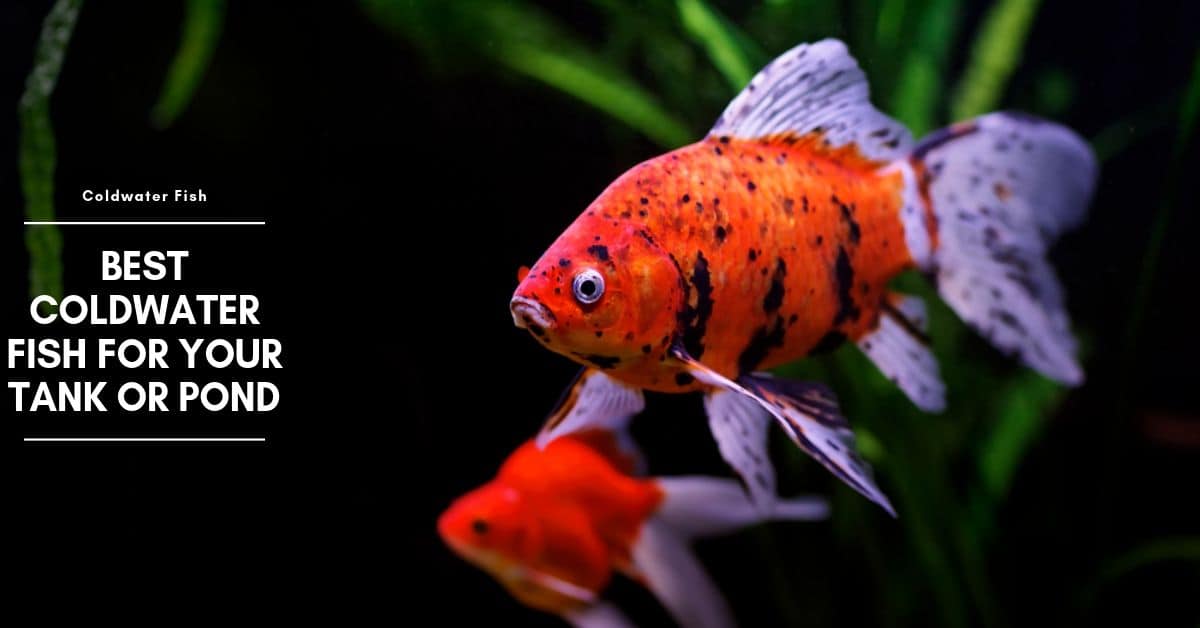In addition to goldfish and some types of koi, most cold-water aquarium fish from a wide range of families thrive in cold water ponds, from small, colorful species, such as this Red Shiner, to prehistoric-looking sturgeon. Keeping these fish in your tank doesn’t need a heater and can thrive very well in low water temperatures.
How do fish survive the winter in ponds?
It has to do with their ability to produce a protective layer of fat.
Fish like trout and goldfish, have specialized cells that surround them. These are called ‘lipids’, fat cells that act as a natural shield against the chilly water in winter ponds.
So although they may look sluggish during these cold months because they’re not moving much or actively feeding, they’re actually quite capable of withstanding freezing conditions in their pools for extended periods of time when other aquatic life may perish from it.
But this natural process does come at a cost for the fish. Not only do the cells slow down their bodily processes, but it is also very hard work to maintain these layers of protection which means using up vital energy that the fish would rather be using to help them hunt or fend off predators. If they get too cold, then they will die.
How cold can fish survive?
When the water in a pond gets cold enough, fish stop eating and their metabolism slows down. The colder it gets, the less complicated their processes become, until it’s negligible. This is why you don’t see swimming fish during winter-time, they can’t be bothered.
Fish in a pond will die at the freezing point of water, and probably sometime before. Below that temperature, body processes are negligible compared to ice growth in the water.
How long can fish survive in freezing water?
This is a question that will vary based on the type of fish, the water temperature where it’s found, and many other environmental factors. The few reports that do exist seem to show that most species die within 10 minutes of being introduced to below-zero temperatures.
It depends on two things: how cold the water gets, and how much oxygen it contains.
When the temperature falls further, less and less oxygen diffuses into the water in winter and early spring. Even the most active fish cannot live in very cold water for very long, because their gills cannot absorb enough oxygen to keep up with their metabolism.
API STRESS COAT Aquarium Water Conditioner 16-Ounce Bottle
Tetra AquaSafe Plus, 8.45 Ounces, aquarium Water Conditioner And Dechlorinator, Model Number: 46798162681
$10.19 (as of December 15, 2025 08:56 GMT +03:00 - More infoProduct prices and availability are accurate as of the date/time indicated and are subject to change. Any price and availability information displayed on [relevant Amazon Site(s), as applicable] at the time of purchase will apply to the purchase of this product.)API TAP WATER CONDITIONER Aquarium Water Conditioner 16-Ounce Bottle
$8.48 (as of December 15, 2025 08:56 GMT +03:00 - More infoProduct prices and availability are accurate as of the date/time indicated and are subject to change. Any price and availability information displayed on [relevant Amazon Site(s), as applicable] at the time of purchase will apply to the purchase of this product.)Here are the best coldwater aquarium fishes for the aquarist.
Orangethroat Darter

- ORIGINS Southeastern Canada and the eastern US, near the Great Lakes; also in Louisiana and Mississippi.
- SIZE 3 in (8 cm).
- DIET Small live foods and the eggs of other fish.
- WATER Temperature 39–68°F (4–20°C); hard (100–150 mg/l) and around neutral (pH 7.0).
- TEMPERAMENT Breeding males are territorial.
These small, bottom-dwelling fish are difficult to observe in ponds but are more visible in well-filtered coldwater aquariums. In a pond setting, they supplement their diet by feeding on aquatic insect larvae. Male Orange-Throated Darters are more brightly colored than females. A rise in water temperature triggers breeding. The female lays several hundred eggs over the course of two or three days and buries them in mulm on the pond floor.
Three-Spined Stickleback
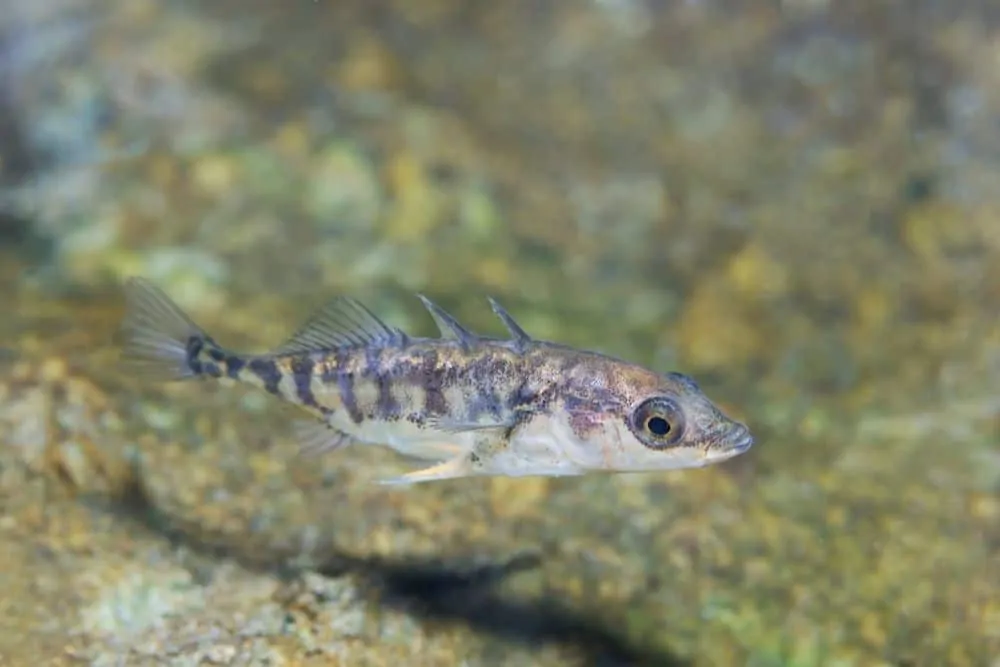
- ORIGINS Occurs widely over much of Europe, northern Asia, and Africa. Also present in North America.
- SIZE 5 in (12.5 cm).
- DIET Prefers fresh and prepared live foods.
- WATER Temperature 39–68°F (4–20°C); soft (50–100 mg/l) and neutral (pH 7.0 ).
- TEMPERAMENT Males become territorial when breeding.
These sticklebacks show a distinct difference in coloration between the sexes during the spawning period when male fish become red and blue.
The male builds a nest out of plant matter and lures a succession of females inside so that they can lay their eggs, which he fertilizes. In total, the nest may contain as many as 50 eggs from different females. The male guards the eggs, and also watches over the newly hatched fry.
Orange-Spotted Sunfish
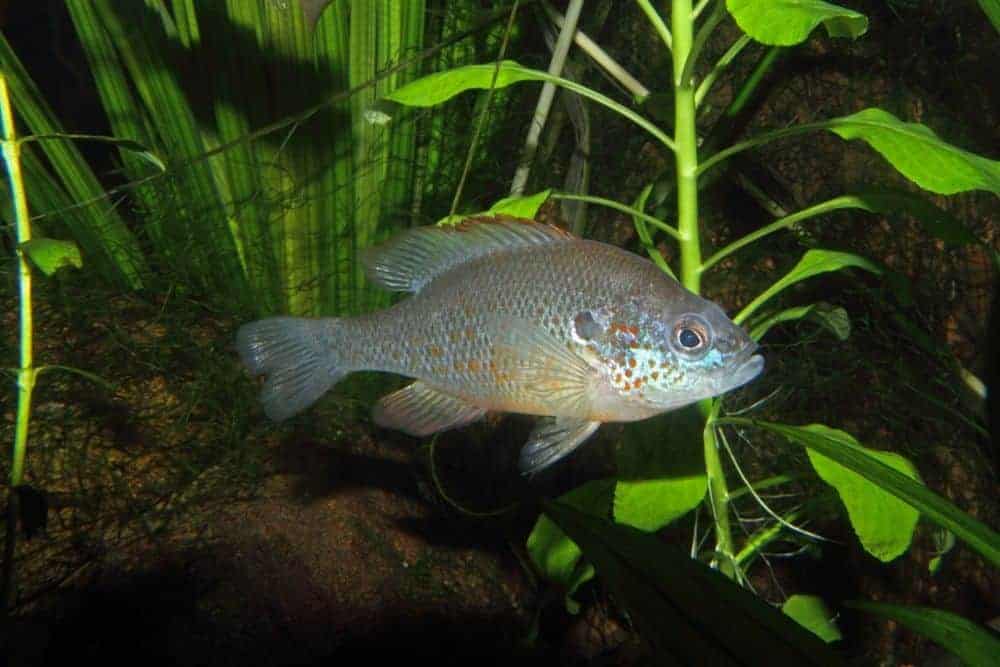
- ORIGINS North America, where it occurs in rivers and lakes from Texas to North Dakota.
- SIZE 4 in (10 cm).
- DIET Mainly live foods of different types.
- WATER Temperature 39–72°F (4–22°C); hard (100–150 mg/l) and neutral (pH 7.0).
- TEMPERAMENT Occasionally aggressive.
The small size of these sunfish, coupled with their attractive appearance, means that they can be kept in coldwater aquariums as well as in ponds. Sexing is quite straightforward since only males display the distinctive reddish-orange spots, which are brown in females.
The white edging around the so-called “ear flap” behind each eye is another point of recognition. Avoid housing them with other sunfish, because they will hybridize readily.
Diamond Sturgeon
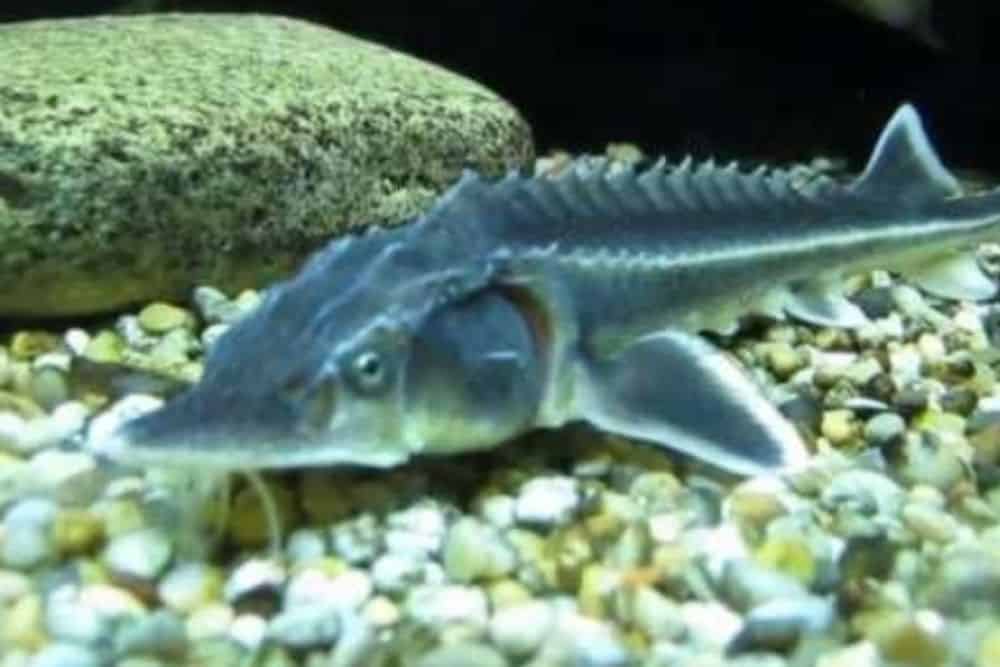
- ORIGINS Europe and western Asia, inhabiting the Azov, Caspian, and Black seas; also ventures into rivers.
- SIZE 48 in (125 cm) in ponds.
- DIET Sturgeon pellets and live foods.
- WATER Temperature 50–68°F (10–20°C); hard (150–200 mg/l) and neutral to alkaline (pH 7.0–7.5 ).
- TEMPERAMENT May prey on small fish.
Young Diamond Sturgeon lose their characteristic white patterning as they mature, becoming grayer with age. House them in a large, well-oxygenated pond that is free from blanketweed, among which they can become trapped.
Sturgeon are highly susceptible to chemical poisoning, so avoid using algicides, which are toxic to these primitive fish, as are some medications.
Siberian Sturgeon
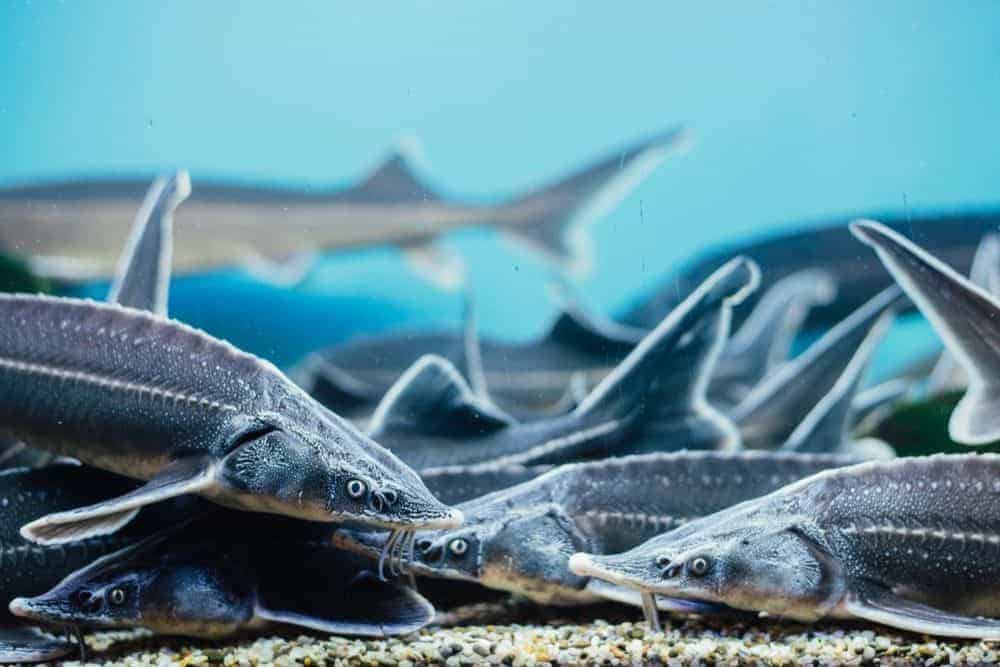
- ORIGINS Rivers in Siberia, from the Kolyma to the Ob; also in some larger lakes, including Lake Baikal.
- SIZE 78 in (200 cm).
- DIET Pellets high in oil and protein. Carnivorous.
- WATER Temperature 50–68°F (10–20°C); hard (150–200 mg/l) and neutral to alkaline (pH 7.0–7.5 ).
- TEMPERAMENT Peaceful.
This fast-growing beautiful fish is gray or black on top, with white underparts. Like other sturgeons, it requires cool surroundings and highly oxygenated water. It digs with its snout for food, which in its natural habitat is mainly invertebrates.
Spawning is not an annual event in the wild, but when a female does spawn, she may lay in excess of 400,000 eggs. This species does not normally breed in ponds.
Sterlet
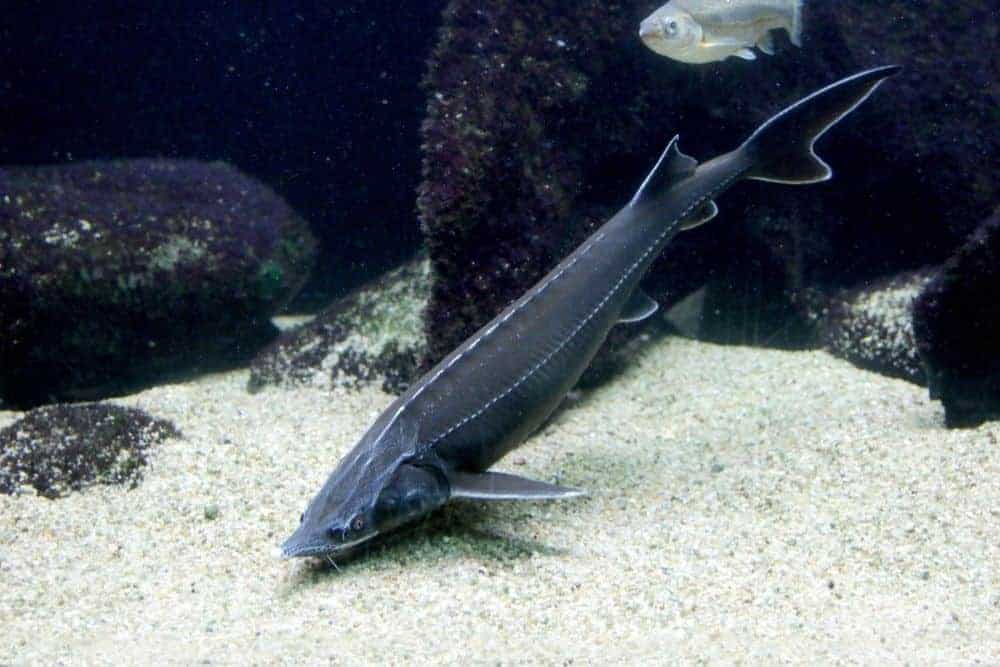
- ORIGINS Range extends from tributaries of rivers feeding the Azov, Caspian, and Black seas to parts of Siberia.
- SIZE 48 in (120 cm).
- DIET Pellets high in oil and protein, plus live foods.
- WATER Temperature 50–68°F (10–20°C); hard (150–200 mg/l) and neutral to alkaline (pH 7.0–7.5).
- TEMPERAMENT May prey on smaller companions.
Sterlets are the most easily accommodated members of the sturgeon family, typically growing more slowly and reaching a smaller size than their relatives. Their name derives from the star-shaped bony scutes set into the skin.
Sterlets are dark in color, although juveniles have white lines along their back and sides, and white borders on their pectoral fins. The smaller, so-called albino variant has a pale yellow coloration that shows up well in the clear water that these fish require.
In the wild, Sterlets spawn between May and June, with some females producing more than 100,000 eggs, which hatch in about five days. However, these fish rarely breed in ponds. When buying young sturgeon, regardless of the species, avoid individuals with slightly bent body shape. This is a sign of malnutrition, which may be hard to reverse, even though specialist sturgeon diets are now available.
Fathead Minnow
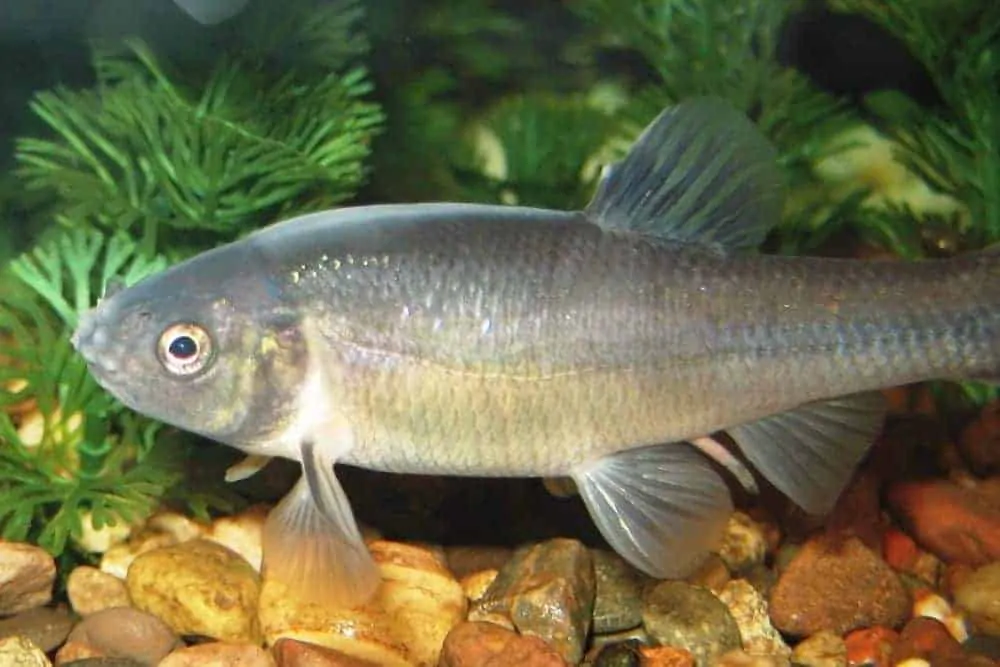
- ORIGINS Found through much of North America, from Canada’s Great Slave Lake southward to Mexico.
- SIZE 4 in (10 cm).
- DIET Flake and pelleted foods.
- WATER Temperature 50–77°F (10–25°C); hard (100–150 mg/l) and neutral to alkaline (pH 7.0–7.5).
- TEMPERAMENT active and social.
These lively shoalers are not entirely hardy, but they can be moved into an indoor tank if necessary to protect them from extreme cold. Sexing is easy during spring when the males develop white spots called tubercles on their gill plates. The female lays her eggs beneath rocks or raised pots, and the male guards them until they hatch about five days later.
Southern redbelly dace
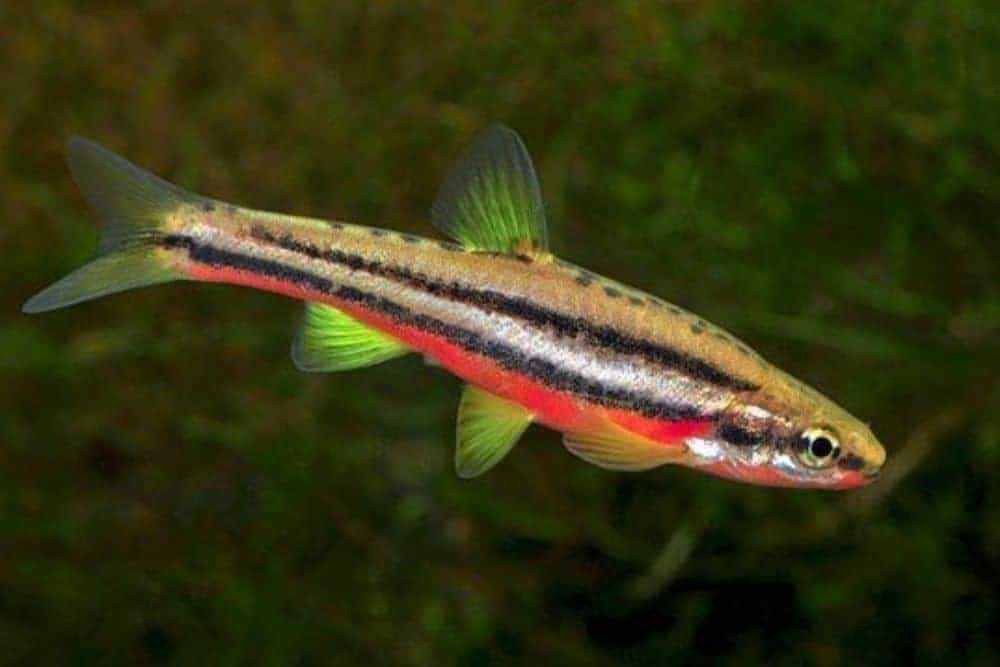
- ORIGINS North America, extending from Minnesota eastward to New York State.
- SIZE 31 ⁄2 in (9 cm).
- DIET Flake, small pellets, and live foods.
- WATER Temperature 50–77°F (10–25°C); hard (100–150 mg/l) and neutral (pH 7.0 ).
- TEMPERAMENT Relatively peaceful.
The small size of these minnows means that their attractive coloration will be difficult to appreciate in a pond setting, and they probably look best in a coldwater aquarium.
Good oxygenation and filtration are important since their natural habitat is fast-flowing streams. Lowering the water temperature over winter and increasing it again in spring should trigger spawning behavior. The female scatters her eggs above the substrate.
Tench
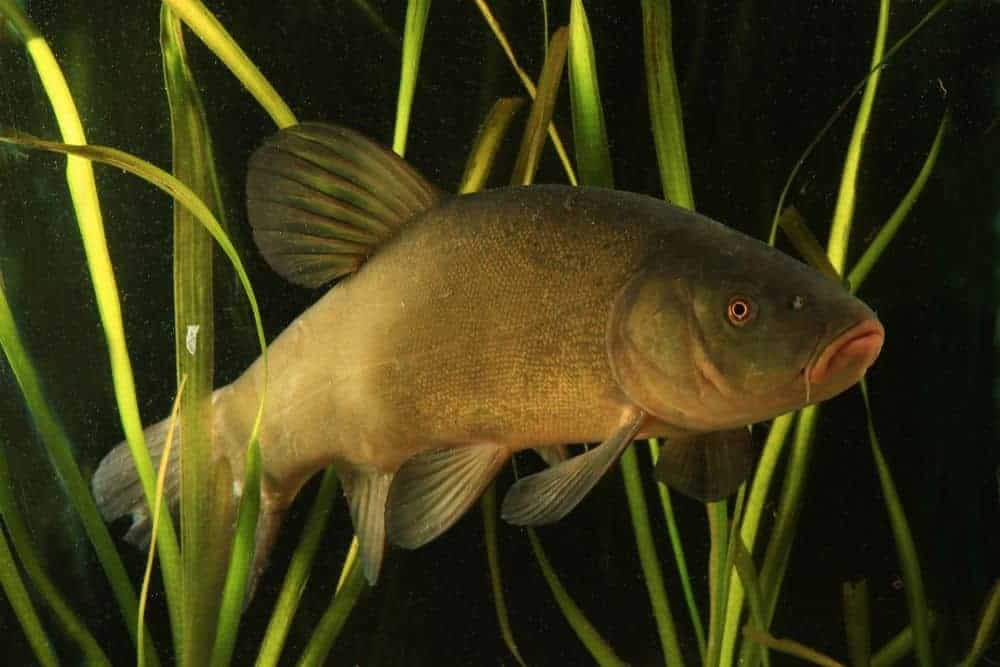
- ORIGINS Occurs naturally throughout much of Europe; absent from the far south and Scandinavia.
- SIZE 2 ft (60 cm).
- DIET Eats pellets, which it may take at the surface.
- WATER Temperature 32–86°F(0–30°C); hard(100–150 mg/l) and around neutral (pH 7.0 ).
- TEMPERAMENT Social; needs to be kept in small shoals
Tench tend to be relatively inconspicuous since they congregate at the bottom of the pond. They are fairly easy to keep, being unfussy about water conditions, although they dislike strong currents.
Adult males are recognizable by their larger pelvic fins, but usually, only young Tench are offered for sale, which makes sexing difficult. A mature female lays hundreds of thousands of eggs over the course of a year. The eggs hatch a week after being laid.
Red-and-White Tench
As in orfe, goldfish, and other carp, this coloration is the result of a natural mutation, which has been enhanced by selective breeding.
Red Tench
This variety is distinguished by vivid orange-red coloration offset against variable dark markings, typically on the head and along the back. The appearance of Red Tench can be improved by color feeding.
Green Tench
This is the natural color form, although its appearance may vary depending on its background. Fish living in water with dense vegetation are a much darker green than those inhabiting sparsely planted ponds.

Hi, my name is Sean, and I’m the primary writer on the site. I’m blogging mostly about freshwater and saltwater aquariums, fish, invertebrates, and plants. I’m experienced in the fishkeeping hobby for many years. Over the years I have kept many tanks, and have recently begun getting more serious in wanting to become a professional aquarist. All my knowledge comes from experience and reading forums and a lot of informative sites. In pursuit of becoming a professional, I also want to inspire as many people as I can to pick up this hobby and keep the public interest growing.
Read more about Sean.
Please join also my Facebook group.

